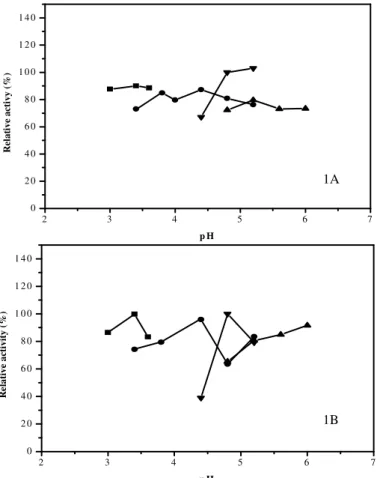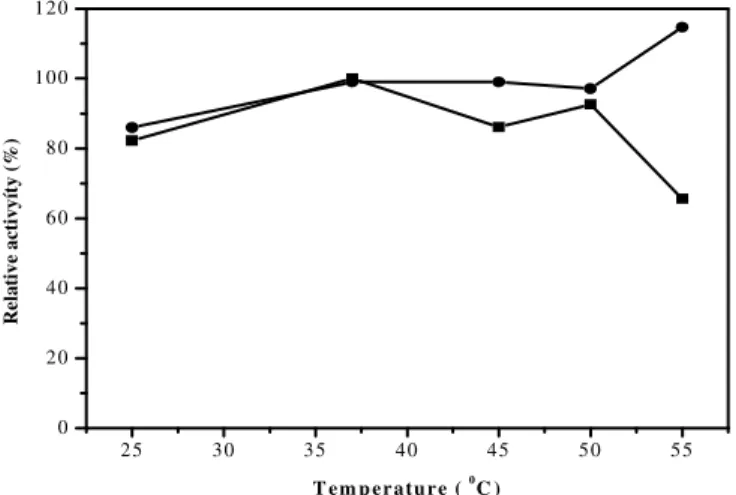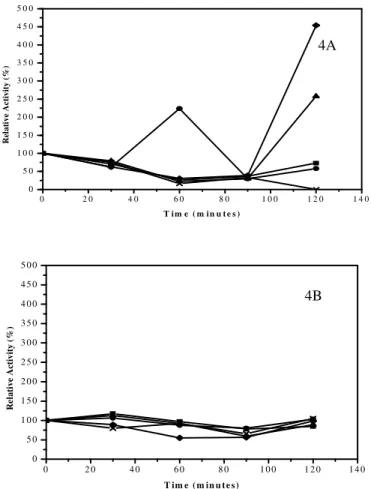Vol.55, n. 5: pp. 671-676, September-October 2012
ISSN 1516-8913 Printed in Brazil BRAZILIAN ARCHIVES OF
BIOLOGY AND TECHNOLOGY
A N I N T E R N A T I O N A L J O U R N A L
Partial Characterization of an Inulinase Produced by
Aspergillus japonicus
URM5633
Anna Carolina da Silva
1, Alana Emilia Soares de França Queiroz
1, Tatiana Souza Porto
1,2,
Michele Rigon Spier
3, Carlos Ricardo Soccol
3, Ana Lúcia Figueiredo Porto
2, Cristina
Maria Souza-Motta
4and Keila Aparecida Moreira
1,2*1Unidade Acadêmica de Garanhuns; Universidade Federal Rural de Pernambuco; Av. Bom Pastor, s/n; 55296-901;
Garanhuns - PE - Brasil. 2Laboratório de Tecnologia de Bioativos; Departamento de Morfologia e Fisiologia Animal; Universidade Federal Rural de Pernambuco; Av. Dom Manuel de Medeiros s/n; 52171-900; Recife - PE - Brasil. 3Departamento de Engenharia de Bioprocessos; Universidade Federal do Paraná; Campus Politécnico 80060-000; Curitiba - PR - Brasil. 4Departamento de Micologia; Universidade Federal de Pernambuco; Av. Prof. Nelson Chaves s/n; 50670-420; Recife - PE - Brasil.
ABSTRACT
Enzymes obtained by fermentation processes offer a number of advantages and have been widely researched and used throughout the world. This study aimed to partially characterise an inulinase produced from palm and cassava peel. The enzyme was produced via the solid-state fermentation of Aspergillus japonicus URM5633. The optimal temperatures were 50°C and 55°C, and the optimal pH values were 5.2 and 3.4 for inulinase fermentatively produced from palm and cassava peel, respectively. The thermostability measurements for inulinase produced in palm showed that the relative activity remained below 100% until 30 minutes of stability for all temperatures, but reached 106.8% at a temperature of 50°C after 60 minutes. Inulinase from the crude extract of cassava peel was pH stable and only decreased to 55% of the maximal activity over the course of the assay, suggesting that this enzyme can be used in inulinase production and can be utilized in food industries.
Key words: inulinase, characterisation, solid-state fermentation, Aspergillus japonicus
*Author for correspondence: moreiralab@yahoo.com.br
INTRODUCTION
Inulinase (2,1-β-D-fructan fructanohydrolases EC 3.2.1.7) hydrolyses inulin into practically pure fructose (Cazetta et al. 2010) and provides an excellent alternative for the production of fructose syrup (Vandamme and Derycke 1983a; Treichel et al. 2009). The polysaccharide inulin has physicochemical properties that can replace both sugar and fat in various food products, and it can be classified as a functional food, or prebiotic, as it confers beneficial physiological effects on human
metabolism (Roberfroid 2002). Fructose formation from inulin offers an advantage as it involves only a single enzymatic step, which yields up to 95% fructose (Pandey et al. 2000).
fermentation process where the microorganisms grow in solid substrates with low water concentration. Many studies on the application of SSF are focused in adding value to agroindustry residues, which have been extensively used as a physical support or source of nutrients in SSF (Mazutti et al. 2006). The enzymes produced by fermentation processes offer a number of advantages and have been widely researched and used throughout the world. The application of enzymes in food technology is a viable alternative because the process consumes little energy, improves the quality of various products and causes minimal environmental impact (Soccol and Vandenberghe 2003). The industrial application of enzymes is determined by enzyme specificity, activity, stability (storage and use), availability and production costs. Enzymes are evaluated in industry by many factors, including the following: the concentration at which the enzyme must be produced; the nature of the enzyme’s substrate; the required concentrations of the necessary co-factors and/ or allosteric effectors; the presence, concentration and types of inhibitors; and the optimal ionic potential, pH, temperature and reaction time (Moreira et al. 2003).
MATERIALS AND METHODS
Microorganism and Agroindustry Residues
Aspergillus japonicus URM5633 was obtained from the collection of URM at the Department of Mycology, Federal University of Pernambuco. The palm and cassava peel were obtained from local farmers in Garanhuns/PE, Brazil.
Production of Inulinase
Fermentations were performed in Erlenmeyer flasks (125 mL) with 10 g of each substrate (either cassava peel or palm). Fermentations were performed at 28ºC ± 2 for 120 hours then stopped to perform the enzymatic extraction.
Enzyme Extraction
The enzyme was extracted after 120 hours of fermentation by adding 25 ml of sodium acetate buffer (20 mM, pH 6.0) to every 10 g of fermented medium, then incubating the mixture in a water bath at 32°C for a period of 1 hour and filtering through a Whatman filter (No. 01).
Determination of Reducing Sugars
To determine the sugars in the samples, we used the dinitrosalicylic acid (DNSA) method (Miller 1959). We added 1000 µL of the reactive DNSA reagent to 100 mL of sample, placed the sample in boiling water for 10 minutes, and then took measurements with a spectrophotometer set to 570 nm. The calibration curve was made from a standard solution of fructose (0 to 5 mg mL-1).
Inulinase Activity
The enzymatic assays were conducted according to a procedure by Kochhar et al. (1999). First, 80
µL of the inulin solution at 1% (w/v) was dissolved in 0.1 M sodium acetate buffer (pH 4.8). The 20 µL sample was incubated at 37°C for 15 minutes. After this period, the reaction was stopped by the addition of 1 mL of the 3,5- DNSA reagent (Miller 1959), and the resulting reducing sugar was monitored. Fructose was used as a standard. One unit of inulinase (U) was defined as the amount of enzyme that produced 1 µmol min-1 of fructose under the assay conditions described above.
Effect of pH on Enzyme Activity
The optimum pH for the enzymatic activity of inulinase was determined using different buffers at 0.2 M. The following buffers were used to test appropriate pH values, which appear in parentheses after the buffer composition: glycine - HCl buffer (pH 3.0, 3.4 and 3.6), citrate buffer (pH 3.4, 3.8, 4.0, 4.4, 4.8 and 5.2), phosphate buffer (pH 4.8, 5.2, 5.6 and 6.0) and sodium acetate buffer (pH 4.4, 4.8 and 5.2). The determination of enzyme activity was performed as described previously.
Effect of Temperature on Enzyme Activity The optimum temperature was determined by measuring the enzymatic activity of the crude extract on inulin solutions (1% w/v) prepared in 0.1 M sodium acetate buffer (pH 4.8); the enzymatic activity was monitored at 25, 37, 45, 50 and 55°C.
Stability of Enzyme at pH
activity of inulinase at time intervals of 30, 60, 90 and 120 minutes.
Enzyme Stability to Temperature
To determine the heat stability, the enzyme was subjected to temperatures of 30, 40, 50, 60 and 70°C. Aliquots were retained to determine the specific activities at time intervals of 30, 60, 90 and 120 minutes. The samples of each interval were subjected to analytical determinations. All tests were performed in triplicate. The minimum significant differences for the Tukey test was P<0.05.
RESULTS AND DISCUSSION
The partial characterisation of inulinase enzyme extracts from palm showed that the optimal pH (Fig. 1A and B) and temperature (Fig. 2) were 5.2 (sodium acetate buffer, 0.2 M) and 37°C, respectively. The enzymatic extract obtained from the fermentation of cassava peel showed that the optimal pH (Fig. 1 B) and temperature (Fig. 2) were 3.4 (glycine-HCl buffer, 0.2 M) and 55ºC, respectively.
2 3 4 5 6 7
0 2 0 4 0 6 0 8 0 1 0 0 1 2 0 1 4 0
R
el
a
ti
v
e
a
ct
iv
y
(
%
)
p H
2 3 4 5 6 7
0 2 0 4 0 6 0 8 0 1 0 0 1 2 0 1 4 0
R
el
a
ti
v
e
a
ct
iv
it
y
(
%
)
p H
Figure 1 - Effect of pH on the relative specific inulinase activity of A. japonicus URM5633 from
palm (A) and cassava peel (B). Buffers - (■) glycine HCl, (•) citrate, (▼) sodium acetate and (▲) citrate phosphate. Mean of three repetitions. Minimum significant differences for the Tukey test (P<0.05).
However, the results in the literature show that optimal activity of inulinase produced by A. niveus 4128URM occurs between a pH range of 4.0 and 7.0 and at a temperature between 45°C and 50°C (Souza-Motta et al. 2005). The enzymes produced
by different substrates display different behaviours across the tested temperature range (Fig. 2). The enzyme produced by the fermentation of palm has a relative activity value that increases from 25 to 35ºC and peaks at 50ºC before sharply declining at
55ºC, where it has the lowest activity. The enzyme produced by the fermentation of cassava peel has activity values that increase until a temperature of
45ºC, decline at 50ºC, then reach a maximum at 55°C.
2 5 3 0 3 5 4 0 4 5 5 0 5 5 0
2 0 4 0 6 0 8 0 1 0 0 1 2 0
R
el
a
ti
v
e
a
ct
iv
y
ít
y
(
%
)
T e m p e r a tu r e ( 0C )
Figure 2 - Effect of temperature on the relative specific inulinase activity of A. japonicus URM
5633 from palm (■) and cassava (•) as substrates. Mean of three Repetitions. Minimum significant differences for the Tukey test (P<0.05).
Some species of Aspergillus produce inulinases with maximum activity at higher temperatures. For example, the inulinase from A. niger 245 has optimal activity at 60ºC (Cruz et al. 1998). However, temperatures above 55ºC may disable some inulinases that are produced by fungi (Vandamme and Derycke 1983b). The stability of inulinase from palm was measured with respect to temperature, and the relative activity remained below 100% up to 30 minutes at all temperatures
(Fig. 3A). At a temperature of 50°C, the relative activity reached 106.8% after 60 minutes of stability; the lowest relative activity, 54.6%, was measured at 30ºC after 120 minutes of stability. After 120 minutes of stability at 50°C, the relative activity reached 118.9%. The enzyme in the crude extract of cassava peel (Fig. 3B) remained above 100% relative activity for all times and temperatures tested, reaching a 276.5% relative activity at 70°C after 90 minutes.
0 20 40 60 80 100 120 140
0 40 80 120 160 200 240 280
R
el
a
ti
v
e
a
ct
iv
it
y
(
%
)
Time (minutes)
0 20 40 60 80 100 120 140
0 40 80 120 160 200 240 280
R
el
a
ti
v
e
a
ct
iv
it
y
(
%
)
Time (minutes)
Figure 3 - Thermal stability of inulinase produced by A. japonicus 5633URM in palm (A) and
cassava (B). Temperatures - 30ºC (■), 40ºC (•), 50º C (▲), 60°C (×) and 70º C (♦).
3A
When analysing the stability of the enzyme at different pH values, it was noted that the inulinaseproduced from palm (Fig. 4A) remained below 100% relative activity at 120 minutes in the glycine HCl buffer (pH 3.0, 0.2 M) and the sodium acetate buffer (pH 4.8, 0.2 M). There is a residual activity of 123.8% for the citrate buffer (pH 3.4, 0.2 M) at 60 minutes and residual activities of 226% and 448% for citrate buffer (pH 4.0, 0.2 M) and phosphate and citrate buffer (pH 5.2, 0.2 M), respectively, after 120 minutes.
The enzyme in the enzymatic extract of cassava peel (Fig. 4B) had a relative activity of more than 100% in glycine buffer (pH 3.0, 0.2 M) and citrate buffer (pH 3.4 or 4.0, 0.2 M), but a relative activity below 100% in sodium acetate buffer (pH 4.8, 0.2 M) and phosphate and citrate buffer (pH 5.2, 0.2 M) after 30 minutes of stability. At 60 and 90 minutes, the stability remained below 100% under all conditions, with the lower activity of 54.8% for the citrate phosphate buffer after 60 minutes of stability.
0 2 0 4 0 6 0 8 0 1 0 0 1 2 0 1 4 0
0 5 0 1 0 0 1 5 0 2 0 0 2 5 0 3 0 0 3 5 0 4 0 0 4 5 0 5 0 0
R
el
a
ti
v
e
A
ct
iv
it
y
(
%
)
T i m e ( m i n u t e s )
0 2 0 4 0 6 0 8 0 1 0 0 1 2 0 1 4 0 0
5 0 1 0 0 1 5 0 2 0 0 2 5 0 3 0 0 3 5 0 4 0 0 4 5 0 5 0 0
R
el
a
ti
v
e
A
ct
iv
it
y
(
%
)
T im e ( m in u t e s )
Figure 4 - Effect of pH on the stability of inulinase produced from palm (4A) and cassava (4B).
Buffers - glycine-HCl pH 3.0 (■), citrate pH 3.4 (•) and 4.0 (▲), sodium acetate pH 4.8 (×) and citrate phosphate pH 5.2 (♦).
CONCLUSIONS
The results above confirm that the action of the inulinase can vary significantly depending on the substrate used to produce the enzyme. Enzyme produced from palm and cassava peel displayed different parameters, such as the optimal temperature and pH, two factors of great importance for enzymes with potential use in biotechnological processes. The inulinase produced in this work has great potential to be used in the fermentation industry due to the impressive values of relative activity.
ACKNOWLEDGMENTS
The authors are grateful to FACEPE, CNPq and FINEP.
REFERENCES
Cazetta ML, Monti R, Contiero J. Effects of culture conditions on the production of inulinase by Kluyveromyces marxianus. Braz. Arch. Biol. Technol. 2010; 53: 701-707.
Cruz VD, Belote JG, Belline MZ, Cruz R. Production and action pattern of inulinase from Aspergillus niger-245: Hydrolysis of inulin from several sources. Rev. Microbiol.1998; 29: 4.
Jing W, Zhengyu J, Bo J, Augustine A. Production and separation of exo- and endoinulinase from Aspergillus ficuum. Process. Biochem. 2003; 39: 5-11.
Kochhar A, Gupta AK, Kaur N. Purification and immobilisation of inilinase from Aspergillus candidus for producing fructose. J. Sci. Food Agri. 1999; 549-554.
Mazutti M, Bender JP, Treichel H, Di Luccio M. Optimization of inulinase production by solid-state fermentation using sugarcane bagasse as substrate. Enzyme Microb. Technol. 2006; 39: 56-59.
Miller GL. Use of dinitrosalicylic acid reagent for determination of reducing sugar. Anal. Chem. 1959; 31: 426-429.
Moreira KA, Porto TS, Texeira MFS, Porto ALF, Lima Filho JL. New alkaline protease from Nocardiopsis sp.: partial purification and characterization. Process Biochem. 2003; 39: 67-72.
Pandey A, Soccol CR, Nigam P, Soccol VT. Biotechnological potential of agro-industrial residues: sugar-cane bagasse. Bioresoure Technol. 2000; 74: 69-80.
Roberfroid MB. Functional food concept and its application to prebiotics. Digest Liver. 2002; 34: 105-109.
Soccol CR, Vandenberghe LPS. Overview of applied solid-state fermentation in Brazil. Biochem. Eng. J. 2003: 13: 205–218.
Souza-Motta CM, Cavalcanti MAQ, Porto ALF, Moreira KA, Lima Filho JL. Aspegillus niveus Blochwitz 4128URM: new source for inulinase production. Braz. Arch. Biol. Technol. 2005; 48: 343-350.
Treichel H, Mazutti M, Maugeri Filho F, Rodrigues MI. Technical viability of the production, partial purification and characterisation of inulinase using pretreated agroindustrial residues, Bioproc. Biosyst. Eng. 2009; 32: 425-433.
Vandamme EJ, Derycke DG. Microbial inulinases: Fermentation process, properties and applications. Advances Appl. Micróbiol. 1983; 29: 139-176.


